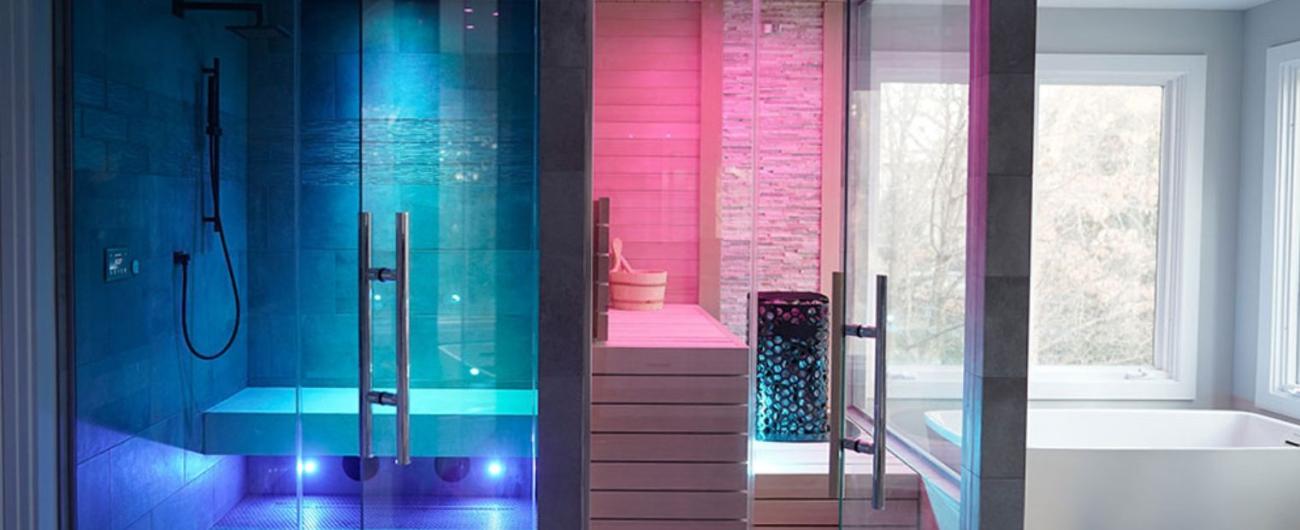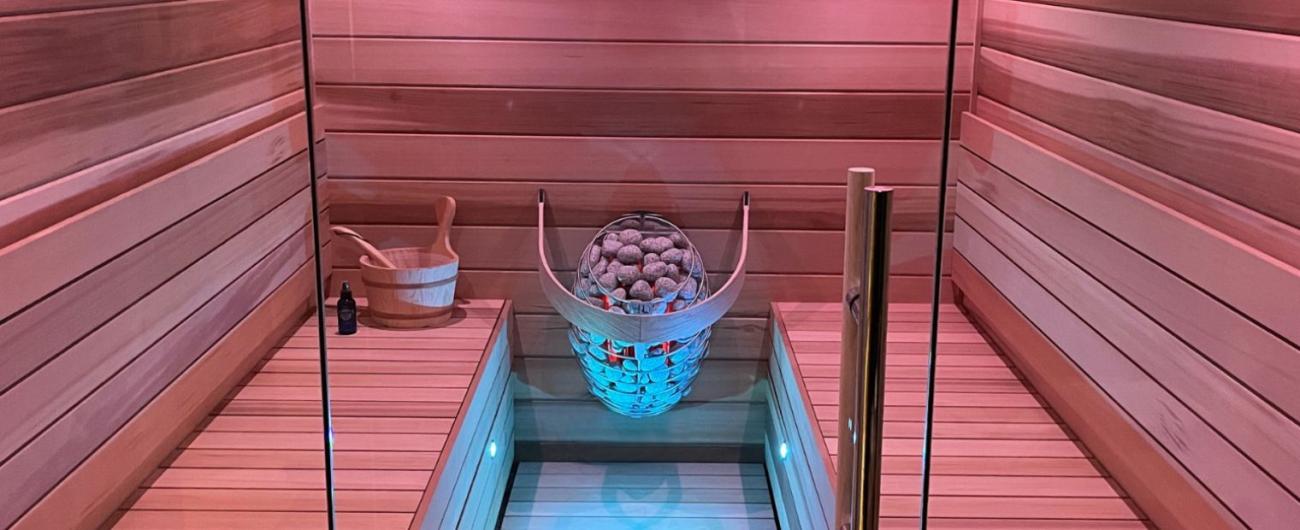January 6, 2023

What's The Difference Between Steam Bath & Sauna?
Since the time of the ancient Greek and Roman Empires, people have understood the health benefits of bathing with heat and steam.
People often wonder if steam baths and saunas are the same. While both are relaxing places to help your body recover, there are a variety of differences between the two. Before deciding which to use, it is important to understand the benefits of each and if they address your unique needs. The most basic difference is that sauna environments are dry, with no visible steam, there is no drain, and the walls and benches are wood. Conversely, steam showers combine heat with heavy, visible steam. Steam showers are more complex and require a greater investment. They must be tiled, plumbed, require drainage and vapor-proof lighting. Most home steam baths also incorporate traditional shower features.
The primary distinction between a steam room and sauna is the type of atmosphere that they create. Saunas produce a dry heat without any visible steam while steam rooms create a moist heat with large amounts of steam. Both types of baths are highly valued for their numerous health benefits, including stress relief and improved circulation. Although steam rooms and saunas are similar in their therapeutic effects, they also have their own unique properties. Saunas are believed to help with stress-relief and blood-flow stimulation, while steam rooms are commonly used to alleviate joint pain or body pains.
Many people discover that they prefer one type of space over the other based on their personal preferences and/or current ailments. Some bathers may view the high, dry heat of a sauna uncomfortable due to respiratory problems such as asthma or sinus congestion, while others may simply prefer the moist heat of a steam room.
The cost of creating a steam shower is similar to other bathroom remodeling projects: labor and material costs. The biggest factors influencing price are the size and style of the shower. Materials typically cost between 15% and 20% of total costs; labor costs account for the remaining 80%. Since you'd use less water per session in a steam shower, significantly less energy is needed to collect and clean that water, compared to a regular shower. Homeowners may be surprised to learn that energy usage is typically less than $1 for an average steam shower session.
Most steam showers are sold as do-it-yourself kits but hiring a professional installation team costs $1,000 to $3,000. Costs can be higher if the home's plumbing system must be modified (like moving water lines) or if the building's electrical system needs to be upgraded for the shower (typically about $2,500). In most cases, prefabricated steam showers cost between $1,000 to $5,000, with most units ranging from $2,500 to $4,000 . This equates to about $70 per square foot on average since most steam showers are 3-by-3-by-7 feet.
Although a sauna is essentially a small, insulated shed with an electric or wood-burning heat source, the cost of owning one varies greatly depending on what type of sauna you get and how often you plan to use it. Basic kits generally start around $2,000 and go up to $7,000 (the cost can increase significantly if you want special features such as lighting or audio systems), while DIY saunas cost around $3,000 to $6,000.

What is a Sauna?
The term “sauna” is a Finnish word that means "clean,” “sweat," or “bath." The term was originally used to describe the traditional Finnish bathhouses called "savusauna" (“smoke sauna"). Today, it's used to describe both traditional steam rooms and modern infrared saunas. A sauna is typically heated between 150° and 190° Fahrenheit to help the body sweat out toxins using dry heat.
There are many different types of saunas, and each offers a myriad of health benefits. A sauna is a small room or building designed as a place to experience dry, humid heat sessions or an establishment with one or more of these facilities. The steam and high heat make the bathers perspire. A thermometer in a sauna is typically used to measure temperature, a hygrometer can be used to measure levels of humidity or steam.
Infrared saunas differ from traditional steam saunas in that they don’t heat the air around you. Instead, they use infrared lamps that use electromagnetic radiation to warm your body directly. An infrared sauna can operate at a lower temperature usually between (120˚F and 140˚F) than a traditional sauna, which is typically between 150˚F and 180˚F.
Manufacturers claim that in an infrared sauna, only about 20 percent of the heat goes to heat the air and the other 80 percent directly heats your body. Infrared therapy is often referred to as a type of sauna, but according to Finnish sauna organizations, infrared is not a sauna. In fact, some Finnish organizations believe that calling it a "sauna" can give it a bad reputation because not all of the Finnish people agree that it should be called that.

What is a Steam Rooms?
A steam room is a virtually steam-tight room where steam is fed with the help of a steam generator. This helps build up the humidity levels to around 100% . Steam rooms are usually finished in ceramic tile and the ceiling must be slanted so that the steam buildup does not drip from the ceiling onto the bathers. The primary goal of steam rooms is to make the bather sweat for detoxification purposes. A steam room is heated between 115 to 120°F.
Steam rooms have been used for centuries to promote health, relaxation, and well-being. They are particularly popular in Scandinavia, Germany, and Russia. They were first developed by the ancient Greeks and Romans who believed that inhaling steam would help cure ailments such as headaches, body aches and even depression. Today they are still used to treat many ailments including arthritis, asthma, stress-related problems and respiratory infections like bronchitis or pneumonia.
Health Effects
Saunas and steam rooms have similar effects on the body. Both cause increased blood flow through better circulation. They dilate blood vessels resulting in a lowering of blood pressure. The heat in steam rooms and saunas causes a lot of perspiration, which releases salt and some toxins from the body. Other health benefits include increased metabolism, an easing of tension in the muscles and promoting feelings of relaxation. The moist heat in steam rooms also helps with nasal congestion.
The release of toxins and the circulation of oxygen-rich blood throughout your body is what makes steam baths and saunas so refreshing and invigorating, but that’s not all. Sitting in a sauna for 20 minutes after a long day or week can be a little slice of heaven when you think about how much it benefits you from head to toe.
Saunas and steam rooms also help with weight loss by encouraging sweating, which means you’ll lose water weight as well as fat. It’s especially helpful if you tend to have lower levels of physical activity than most people do because it helps you shed excess fat without doing anything extra for the most part, these benefits happen while you lie there comfortably, letting your skin dry out naturally in the heat. All this is enough reason to enjoy this relaxing trend occasionally.
